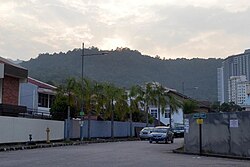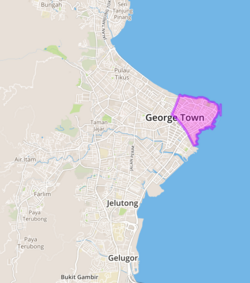Mount Erskine
| Mount Erskine | |
|---|---|
| Neighbourhood of George Town | |
| Other transcription(s) | |
| • Chinese |
白云山 (Simplified) 白雲山 (Traditional) |
| • Hokkien | pe̍h hûn soaⁿ |
 |
|
| Location of Mount Erskine in George Town, with the city centre's UNESCO World Heritage Site in purple. | |
| Coordinates: 5°26′54.744″N 100°18′3.5568″E / 5.44854000°N 100.300988000°ECoordinates: 5°26′54.744″N 100°18′3.5568″E / 5.44854000°N 100.300988000°E | |
| Country |
|
| State |
|
| District | Northeast Penang Island |
| City |
|
| Government | |
| • Local government | Penang Island City Council |
| • Mayor of Penang Island | Maimunah Mohd Sharif |
| • Kebun Bunga State Assemblyman | Cheah Kah Peng (PKR) |
| • Bukit Bendera Member of Parliament | Zairil Khir Johari (DAP) |
| Time zone | MST (UTC+8) |
| • Summer (DST) | Not observed (UTC) |
| Postal code | 10470 |
| Website | mbpp |
Mount Erskine is a residential neighbourhood northwest of the city of George Town in Penang, Malaysia. This hilly neighbourhood, 4 km (2.5 mi) from George Town proper, is situated between the Tanjung Tokong and Pulau Tikus suburbs to the north and to the south respectively.
Notable for its large Chinese cemeteries established by the Cantonese, Teochew and Hokkien communities on Penang Island, the neighbourhood witnesses a considerable increase in activity during the annual Qingming Festival.
Mount Erskine was named after John James Erskine, a member of George Town's committee of assessors around 1810; this committee would become the predecessor to the present-day Penang Island City Council.
The Chinese cemeteries in the area date back to the early 19th century. The southern cemetery, nearest to Gottlieb Road, is managed by the United Hokkien Cemeteries and serves as the final restinig place for Penang's Hokkien community. Meanwhile, the northern cemetery is owned by the Kwangtung and Tengchow Association, a joint organisation that represents the Cantonese and the Teochews. The first tomb within this cemetery dates back to 1795.
The two large cemeteries in Mount Erskine did not deter urbanisation from creeping into the area. In the 1970s, residential estates surrounding the cemeteries were created, particularly around Pepper Estate to the north and Hong Seng Estate to the west. Apartments, such as Taman Evergreen, were also constructed later.
Among the more recent issues affecting this neighbourhood are the continuing development of the hilltop, which has been flattened for the construction of more residential properties, and the risk of landslides at Hong Seng Estate.
...
Wikipedia

